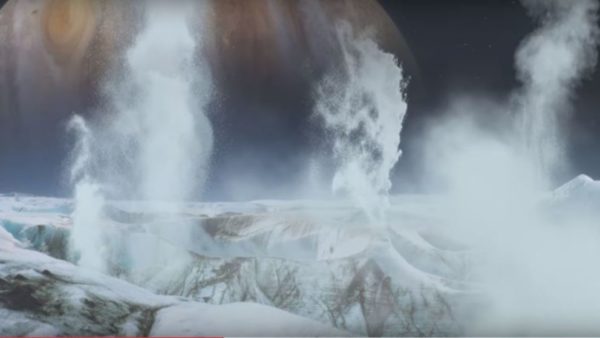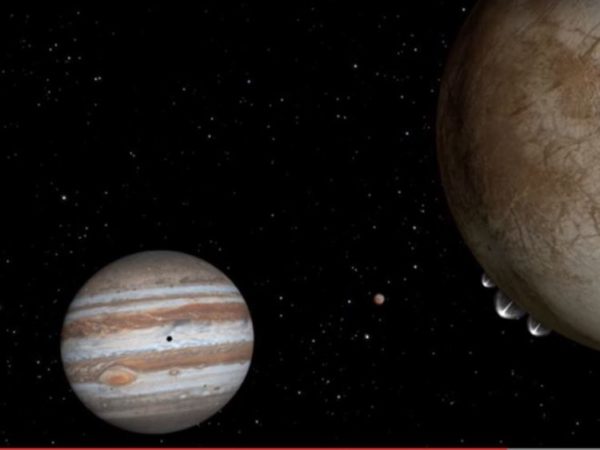
On Sept. 20, 2016, the United States National Aeronautics and Space Administration (NASA) announced that it will release details of ‘surprising activity’ on Europa on Sept. 26, via a teleconference.
Immediately after NASA issued the statement, fevered speculations about alien life appeared on social media. The speculations emerged due to researchers in the past having said Europa is one of the best places to find alien life in the solar system. In fact, some astrobiologists have even theorized that organisms could survive in its oceans.
I really want it to be aliens. Just once.
Unless they are the murdery-type of alien, then natural processes are okhttps://t.co/9XydRjS1S9
— Edward Clark (@Paladin1969) September 20, 2016
Europa is one of the largest of Jupiter’s 67 known moons, captured by the Hubble Space Telescope. Researchers say it is the sixth-closest moon of Jupiter, and the smallest of its four Galilean satellites, as well as the sixth-largest moon in the solar system. Its distance to Earth is approximately 628.3 million km. Jupiter is the largest planet in our solar system and fifth from the sun
During the much anticipated teleconference on Sept. 26, NASA announced that it has discovered a remarkable and spectacular happening on Europa. Researchers at NASA revealed that by the help of the Hubble Space Telescope, they have observed, what is believed to be plumes of water spewing from the surface of Europa. The team who made the discovery is said to be led by William Sparks of the Space Telescope Science Institute in Baltimore. The team observed Europa passing in front of Jupiter on 10 separate occurrences, spanning 15 months. They then saw what could be plumes erupting on three of these occasions. The plumes are estimated to rise about 125 miles (200 kilometers) before, presumably, raining material back down onto Europa’s surface.
According to NASA, this observation means missions to Europa may be able to take samples from its ocean without having to drill through miles of ice. In late 2013, the Hubble telescope observed water vapor erupting from Europa. Many researchers hailed the development as a ‘tremendously exciting’ discovery. Even before the 2013 discovery, previous scientific findings on Europa had revealed existence of a possible ocean located under its icy crust. Researchers who made the discovery theorized then, that if the ice on the surface of the moon is drilled to the ground, oceans will be detected. This discovery on Europa fueled the debate about the possibility of alien life. Lorenz Roth of Southwest Research Institute in San Antonio said at the time, that if the plumes of vapor were connected to the ocean beneath the crust, they could start searching for life nearer the surface.
NASA said: “Europa’s ocean is considered to be one of the most promising places that could potentially harbor life in the Solar System. It is a significant finding which could provide a tantalizing opportunity.”
The acting associate administrator for NASA’s Science Mission Directorate in Washington, Geoff Yoder told reporters in an interview: “These plumes, if they do indeed exist, may provide another way to sample Europa’s subsurface.”
NASA stated further that Europa’s ocean contains twice as much water as all of Earth’s oceans combined. The ocean is said to be protected by a layer of extremely cold and hard ice, which is of unknown thickness.
According to NASA, it will conduct further studies, in order to fully confirm if the plumes detected are really water. The space agency is planning to use the infrared vision of the James Webb Space Telescope, which is scheduled to launch in 2018, to confirm the activity it has observed on Europa. Again, NASA is planning to send a robotic spacecraft, equipped with a suite of scientific instruments, to circle Europa in the 2020s
If these missions are successful and they confirm that the plumes detected are water, Europa would be the second moon in the solar system known to have water vapor plumes. In 2005, NASA’s Cassini orbiter detected jets of water vapor and dust spewing off the surface of Saturn’s moon, Enceladus.
This NASA discovery has increased belief among alien life adherents, that life exists somewhere in our solar system apart from Earth. In the past, the famous British Theoretical Physicist, Professor Stephen Hawking said in a universe with 100 billion galaxies, with each containing hundreds of millions of stars, it’s unlikely that Earth is the only place where life has evolved. He said his mathematical brain has rationalized that there is life somewhere else, apart from what exists on our planet.
You want to support Anonymous Independent & Investigative News? Please, follow us on Twitter: Follow @AnonymousNewsHQ
This article (NASA Discovery Suggest Life Might Exist on Europa, Finds Plumes of Water Spewing from Surface [Video]) is a free and open source. You have permission to republish this article under a Creative Commons license with attribution to the author and AnonHQ.com.







